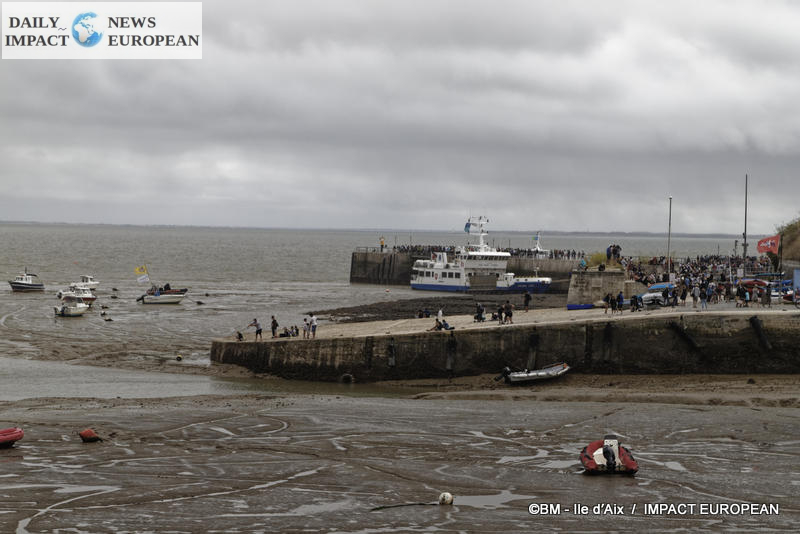Île d’Aix is not linked to the mainland by a bridge. The only way to get there all year round is by boat, unlike the Ile de Ré and Oléron.
The visit of this islet classified on the list of natural sites, is done on foot, by bike or by horse-drawn carriage. In addition to its white houses with tiled roofs and colored shutters, the island has many tourist and historical places.
There are few year-round residents, less than 250 people. This figure increases in the spring and can reach 5,000 during the summer. It is easily accessible from Pointe de la Fumée where a shuttle leaves every 20 minutes. The journey is longer from the island of La Rochelle, Rochefort, Île de Ré or Oléron.
Covered for the most part with forests, marshes, vineyards, sandy coves, cliffs and its 5 beaches, you can explore the island on foot or by bike without cars, on 15 km of trails.
The Grande Plage on the island of Aix and its view of Fort Boyard welcomes swimmers. The other beaches (Golden Sands beach for sunbathing, Seashell Beach, Baby Beach which looks like a Mediterranean cove) are not very busy. Jamblet Beach allows fishing on foot, far from the oyster beds in order to respect the work of oyster farmers …
Ile D’Aix and Napoleon
Napoleon spent his last 3 days on French territory on the island of Aix, from July 12 to 15, 1815, before going into exile in Saint Helena. Thinking of embarking for the United Kingdom, he was taken directly to Ste-Hélène where he died. However, the Emperor’s shadow hangs over the island through the memories he left there: Fort Boyard and Fort Liédot, the Napoleonic Museum, the Place d’Austerlitz, the rue Napoléon and all those bearing the name of his battles.
Fort Boyard and Fort Liérot
During the war between France and England, Napoleon ordered Ferregeau, inspector general of maritime works, to build Fort Boyard in 1801 to cut off the Antioch sluice from the English. He then carried out other large-scale constructions: the house of the Commandant of the Place, current Napoleon Museum, Fort Liédot, Fort de la Rade, the Montalembert and Vaudreuil barracks as well as various batteries on the west side of the island. .
Going to the island of Aix for an inspection tour of the current construction sites, in 1808, he decided to build Fort Liédot in the north of the island, a powder magazine and a house for the commander of the place. Ironically, this will be his last home on French soil, 7 years later. There he wrote the letter which placed him under the protection of the British government.
Fort Liédot, was built according to sketches by Napoleon 1st. A true architectural masterpiece, it presents itself as the guardian of the island and the arsenal of Rochefort. .
Napoleon Museum
Baron Napoléon Gourgaud, great-grandson of General Gaspard Gourgaud, companion of the Emperor in Ste-Hélène, bought the house of the Commandant de la Place in 1926. It became a museum open to the public in 1928 and then donated to national museums in 1933, since 1959 it has been attached to the national museum of the castles of La Malmaison and Bois Préau.
An attic pierced with semi-circular dormers surmounts the house which opens with a peristyle of Doric columns. The pediment and the eagle which surmounts it were added under the Second Empire. We can read this inscription: « In memory of our immortal Emperor Napoleon I, July 15, 1815. Everything was sublime in him: his glory, his reverses. And his respected name hovers over the universe ».
Each room corresponds to a subject: General Gourgaud, the Consulate, the imperial family, the history of the Empire of the coronation at Waterloo, the island of Aix and Saint Helena, the Return of the Ashes and the Napoleonic legend.
Other sites to visit on the island:
- The African Museum, in the rue Napoléon, brings together the zoological and ethnological collections brought back from Africa by Baron Gourgaud. We discover the naturalized dromedary that Napoleon rode during the Egyptian campaigns and a diorama of the birds of St. Helena.
- la Maison de la Nacre: The construction of the shell of the mollusks unveiled by the last mother-of-pearl in France.
- The Jamblet battery: Free access to museum space on the military history of the island.
Share this content:

















Plus d'histoires
Lupiac Honors Its Musketeers at the d’Artagnan Festival – 17th Century Journey
Pagax Castle: History, Legends and Medieval Shows
The medieval festival of the Middle Ages in Île-de-France in Provins